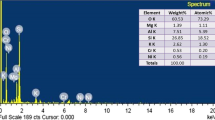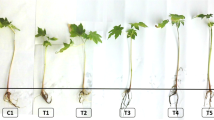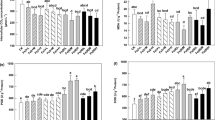Abstract
Iron (Fe) toxicity in plant species depends on the availability of Fe in the soil, uptake ability by the root system, and translocation rate to other parts of the plant. The aim of this study was to assess Fe uptake by root tissues of Catharanthus roseus, translocation rate to leaf tissues, and the impairment of plant physio-morphological characteristics. Fe uptake by the roots (~ 700 µg g−1 DW) of C. roseus was observed during the early exposure period (1 week), and translocation factor from root to shoot was fluctuated as an independent strategy. A high level of Fe content in the root tissues significantly inhibited root length and root dry weight. Under acidic pH condition, an enrichment of Fe in the shoots (~ 400 µg g−1 DW) led to increase in leaf temperature (> 2.5 °C compared to control) and crop stress index (> 0.6), resulting in stomatal closure, subsequently decreasing CO2 assimilation rate and H2O transpiration rate. An increment of CSI in Fe-stressed plants was negatively related to stomatal conductance, indicating stomatal closure with an increase in Fe in the leaf tissues. High Fe levels in the leaf tissues directly induced toxic symptoms including leaf bronzing, leaf spotting, leaf necrosis, leaf chlorosis, and leaf senescence in C. roseus plants. In summary, C. roseus was identified as a good candidate plant for Fe phytoextraction, depending on Fe bioaccumulation, therefore 50 mM Fe treatment was designated as an excess Fe to cause the growth inhibition, especially in the prolonged Fe incubation periods.
Graphical abstract







Similar content being viewed by others
References
Ahmad R, Misra N (2014) Evaluation of phytoremediation potential of Catharanthus roseus with respect to chromium contamination. Am J Plant Sci 5:47702. https://doi.org/10.4236/ajps.2014.515251
Alhdad GM, Zörb C, Al-Azzawi MJ, Flowers TJ (2015) Is the reduced growth of the halophyte Suaeda maritima under hypoxia due to toxicity of iron or manganese? Environ Exp Bot 116:61–70. https://doi.org/10.1016/j.envexpbot.2015.03.002
Askary M, Amirjani MR, Saberi T (2017) Comparison of the effects of nano-iron fertilizer with iron-chelate on growth parameters and some biochemical properties of Catharanthus roseus. J Plant Nutr 40:974–982. https://doi.org/10.1080/01904167.2016.1262399
Aung MS, Masuda H (2020) How does rice defend against excess iron? Physiological and molecular mechanisms. Front Plant Sci 11:1102. https://doi.org/10.3389/fpls.2020.01102
Aziz S, Saha K, Sultana N, Nur HP, Ahsan MA, Ahmed S, Hossain MK (2016) Comparative studies of elemental composition in leaves and flowers of Catharanthus roseus growing in Bangladesh. Asian Pac J Trop Biomed 6:50–54. https://doi.org/10.1016/j.apjtb.2015.10.003
Banyal A, Tiwari S, Sharma A, Chanana I, Patel SKS, Kulshrestha S, Kumar P (2023) Vinca alkaloids as a potential cancer therapeutics: recent update and future challenges. 3 Biotech 13:1–17. https://doi.org/10.1007/s13205-023-03636-6
Bravo S, Amorós JA, Pérez-De-Los-Reyes C, García FJ, Moreno MM, Sánchez-Ormeño M, Higueras P (2017) Influence of the soil pH in the uptake and bioaccumulation of heavy metals (Fe, Zn, Cu, Pb and Mn) and other elements (Ca, K, Al, Sr and Ba) in vine leaves, Castilla-La Mancha (Spain). J Geochem Explor 174:79–83. https://doi.org/10.1016/j.gexplo.2015.12.012
Casierra-Posada F, Cortés-Bayona JD, Cutler J (2017) Effect of iron excess on growth of sisal plants (Furcraea hexapetala). Gesunde Pflanzen 69:123–129. https://doi.org/10.1007/s10343-017-0396-6
Chai YN, Schachtman DP (2022) Root exudates impact plant performance under abiotic stress. Trend Plant Sci 27:80–91. https://doi.org/10.1016/j.tplants.2021.08.003
Cha-um S, Supaibulwatana K, Kirdmanee C (2007) Glycinebetaine accumulation, physiological characterizations and growth efficiency in salt-tolerant and salt-sensitive lines of indica rice (Oryza sativa L. ssp. indica) in response to salt stress. J Agron Crop Sci 193:157–166. https://doi.org/10.1111/j.1439-037X.2007.00251.x
Chen Q, Lu X, Guo X, Pan Y, Yu B, Tang Z, Guo Q (2018) Differential responses to Cd stress induced by exogenous application of Cu, Zn or Ca in the medicinal plant Catharanthus roseus. Ecotoxicol Environ Safe 157:266–275. https://doi.org/10.1016/j.ecoenv.2018.03.055
Coelho DG, da Silva VM, Gomes Filho AAP, Oliveira LA, de Araújo HH, dos Santos FF, Araújo WL, de Oliveira JA (2023) Bioaccumulation and physiological traits qualify Pistia stratiotes as a suitable species for phytoremediation and bioindication of iron-contaminated water. J Hazard Mater 446:130701. https://doi.org/10.1016/j.jhazmat.2022.130701
Connorton JM, Balk J, Rodríguez-Celma J (2017) Iron homeostasis in plants—a brief overview. Metallomics 9:813–823. https://doi.org/10.1039/c7mt00136c
da Silva BV, de Oliveira TDR, Aragão VPM, de Carvalho AJC, Freitas MSM, Silveira V, Ramos AC, Santa-Catarina C (2023) Iron (II) sulfate and pH decrease seed germination and seedling growth and alter nutrient and polyamine contents in Cedrela fissilis Vellozo (Meliaceae). Braz J Bot 46:281–292. https://doi.org/10.1007/s40415-023-00878-9
Das S, Tyagi W, Rai M, Yumnam JS (2017) Understanding Fe2+ toxicity and P deficiency tolerance in rice for enhancing productivity under acidic soils. Biotechnol Genet Eng Rev 33:97–117. https://doi.org/10.1080/02648725.2017.1370888
Das U, Islam MR, Akther MS, Prity SA, Parvez MS, Kabir AH (2021) The downregulation of Fe-acquisition genes in the plasma membrane along with antioxidant defense and nitric oxide signaling confers Fe toxicity tolerance in tomato. Sci Hortic 279:109897. https://doi.org/10.1016/j.scienta.2021.109897
de Araújo TO, Isaure MP, Alchoubassi G, Bierla K, Szpunar J, Trcera N, Chay S, Alcon C, da Silva LC, Curie C, Mari S (2020a) Paspalum urvillei and Setaria parviflora, two grasses naturally adapted to extreme iron-rich environments. Plant Physiol Biochem 151:144–156. https://doi.org/10.1016/j.plaphy.2020.03.014
de Araújo TO, Freitas-Silva L, de Silva OFM, Ribeiro C, Kuki KN, Pereira EG, Nuneo-Nesi A, Silva LC (2020b) Understanding photosynthetic and metabolic adjustments in iron hyperaccumulators grass. Theor Exp Plant Physiol 32:147–162. https://doi.org/10.1007/s40626-020-00176-9
Delias DS, daSilva CJ, Martins AC, de Oliveira DS, do Amarante L, (2022) Iron toxicity increases oxidative stress and impairs mineral accumulation and leaf gas exchange in soybean plants during hypoxia. Environ Sci Pollut Res 29:22427–22438. https://doi.org/10.1007/s11356-021-17397-3
Dong Y, Wang G, Stevanato P, Geng G, Yu L, Wang Y (2022) Physiological response of sugar beet seedlings to ferrous, hypoxia, and interactive ferrous-hypoxia stresses. J Soil Sci Plant Nutr 22:4249–4261. https://doi.org/10.1007/s42729-022-01023-3
El Rasafi T, Pereira R, Pinto G, Gonçalves FJ, Haddioui A, Ksibi M, Römbke J, Sousa JP, Marques CR (2020) Potential of Eucalyptus globulus for the phytoremediation of metals in a Moroccan iron mine soil—a case study. Environ Sci Pollut Res 28:15872–15793. https://doi.org/10.1007/s11356-020-11494-5
Ferreira AD, Queiroz HM, Otero XL, Barcellos D, Bernardino ÂF, Ferreira TO (2022) Iron hazard in an impacted estuary: Contrasting controls of plants and implications to phytoremediation. J Hazard Mater 428:128216. https://doi.org/10.1016/j.jhazmat.2022.128216
Gao F, Dubos C (2020) Transcriptional integration of the plant responses to iron availability. J Exp Bot 72:2056–2070. https://doi.org/10.1093/jxb/eraa556
Kar S, Panda SK (2020) Iron homeostasis in rice: deficit and excess. Proc Nat Acad Sci India Sect B Biol Sci 90:227–235. https://doi.org/10.1007/s40011-018-1052-3
Karahan F (2023) Evaluation of trace element and heavy metal levels of some ethnobotanically important medicinal plants used as remedies in Southern Turkey in terms of human health risk. Biol Trace Element Res 201:493–513. https://doi.org/10.1007/s12011-022-03299-z
Kobayashi T, Nozoye T, Nishizawa NK (2019) Iron transport and its regulation in plants. Free Rad Biol Med 133:11–20. https://doi.org/10.1016/j.freeradbiomed.2018.10.439
Kroh GE, Pilon M (2020) Regulation of iron homeostasis and use in chloroplasts. Int J Mol Sci 21:3395. https://doi.org/10.3390/ijms21093395
Krohling CA, Eutrópio FJ, Bertolazi AA, Dobbss LB, Campostrini E, Dias T, Ramos AC (2016) Ecophysiology of iron homeostasis in plants. Soil Sci Plant Nutr 62:39–47. https://doi.org/10.1080/00380768.2015.1123116
Kumar S, Singh B, Singh R (2022) Catharanthus roseus (L.) G. Don: a review of its ethnobotany, phytochemistry, ethnopharmacology and toxicities. J Ethnopharmacol 284:114647. https://doi.org/10.1016/j.jep.2021.114647
Lapaz ADM, de Camargos LS, Yoshida CHP, Firmino AC, de Figueiredo PAM, Aguilar JV, Nicoli AB, de Priva WS, Cruz VH, Tomaz RS (2020) Response of soybean to soil waterlogging associated with iron excess in the reproductive stage. Physiol Mol Biol Plant 26:1635–1648. https://doi.org/10.1007/s12298-020-00845-8
Lapaz ADM, Yoshida CHP, Gorni PH, Freitas-Silva LD, Araújo TDO, Ribeiro C (2022) Iron toxicity: effects on the plants and detoxification strategies. Acta Bot Bras 36:e2021abb0131. https://doi.org/10.1590/0102-33062021abb0131
Liu XX, Zhu XF, Zheng SJ, Jin CW (2023) Beyond iron-storage pool: functions of plant apoplastic iron during stress. Trend Plant Sci. https://doi.org/10.1016/j.tplants.2023.03.007
Maxwell K, Johnson GN (2000) Chlorophyll fluorescence—a practical guide. J Exp Bot 51:659–668. https://doi.org/10.1093/jexbot/51.345.659
Mazaheri-Tirani M, Kashani A, Koohi-Dehkordi M (2022) The role of iron nanoparticles on morpho-physiological traits and genes expression (IRT 1 and CAT) in rue (Ruta graveolens). Plant Mol Biol 110:147–160. https://doi.org/10.1007/s11103-022-01292-7
Mazumdar K, Das S (2015) Phytoremediation of Pb, Zn, Fe, and Mg with 25 wetland plant species from a paper mill contaminated site in Northeast India. Environ Sci Pollut Res 22:701–710. https://doi.org/10.1007/s11356-014-3377-7
Mnafgui W, Rizzo V, Muratore G, Hajlaoui H, de Oliveira SB, Mnafgui K, Elleuch A (2022) Trigonella foenum-graecum morphophysiological and phytochemical processes controlling iron uptake and translocation. Crop Pasture Sci. https://doi.org/10.1071/CP21419
Müller C, da Silveira Silveira SF, de Menezes DD, Mendes GC, Merchant A, Kuki KN, Oliva MA, Loureiro ME, Almeida AM (2017) Ecophysiological responses to excess iron in lowland and upland rice cultivars. Chemosphere 189:123–133. https://doi.org/10.1016/j.chemosphere.2017.09.033
Neves NR, Oliva MA, da Cruz CD, Costa AC, Ribas RF, Pereira EG (2009) Photosynthesis and oxidative stress in the restinga plant species Eugenia uniflora L. exposed to simulated acid rain and iron ore dust deposition: potential use in environmental risk assessment. Sci Total Environ 407:3740–3745. https://doi.org/10.1016/j.scitotenv.2009.02.035
Noormohammadi Z, Asghari-Mooneghi N, Farahani F (2020) Effect of gamma radiation on morphological and genetic variation in regenerated plantlets Catharanthus roseus L. (G) Don. Genetika 52:15–28. https://doi.org/10.2298/GENSR2001015N
Ojeda-Rivera JO, Oropeza-Aburto A, Herrera-Estrella L (2020) Dissection of root transcriptional responses to low pH, aluminum toxicity and iron excess under Pi-limiting conditions in Arabidopsis wild-type and stop1 seedlings. Front Plant Sci 11:01200. https://doi.org/10.3389/fpls.2020.01200
Pham HNT, Vuong QV, Bowyer MC, Scarlett CJ (2020) Phytochemicals derived from Catharanthus roseus and their health benefits. Technologies 8:80. https://doi.org/10.3390/technologies8040080
Phukunkamkaew S, Tisarum R, Pipatsitee P, Samphumphuang T, Maksup S, Cha-um S (2021) Morpho-physiological responses of indica rice (Oryza sativa sub. indica) to aluminum toxicity at seedling stage. Environ Sci Pollut Res 28:29321–29331. https://doi.org/10.1007/s11356-021-12804-1
Pinto SDS, Souza AED, Oliva MA, Pereira EG (2016) Oxidative damage and photosynthetic impairment in tropical rice cultivars upon exposure to excess iron. Sci Agric 73:217–226. https://doi.org/10.1590/0103-9016-2015-0288
Qurban M, Mirza CR, Khan AHA, Khalifa W, Boukendakdji M, Achour B, Yousaf S, Nawaz I, Butt TA, Iqbal M (2021) Metal accumulation profile of Catharanthus roseus (L.) G Don and Celosia argentea L. with EDTA co-application. Processes 9:598. https://doi.org/10.3390/pr9040598
Rai S, Singh PK, Mankotia S, Swain J, Satbhai SB (2021) Iron homeostasis in plants and its crosstalk with copper, zinc, and manganese. Plant Stress 1:100008. https://doi.org/10.1016/j.stress.2021.100008
Riaz N, Guerinot ML (2021) All together now: regulation of the iron deficiency response. J Exp Bot 72:2045–2055. https://doi.org/10.1093/jxb/erab003
Rout GR, Sahoo S (2015) Role of iron in plant growth and metabolism. Rev Agric Sci 3:1–24. https://doi.org/10.7831/ras.3.1
Rusmanta Y, Ahmad A, Raya I, Ibrahim B (2019) Accumulation of iron by perumpung (Phragmites karka) and its adaptation in various pH of hydroponic solution. J Phys Conf Ser 1341:032030. https://doi.org/10.1088/1742-6596/1341/3/032030
Saadedin SM (2018) Genetic diversity and alkaloids profile evaluation of Catharanthus roseus L. based on RAPD molecular markers and RP-HPLC analysis. Pak J Biotechnol 15:541–551
Sabet H, Mortazaeinezhad F (2018) Yield, growth and Fe uptake of cumin (Cuminum cyminum L.) affected by Fe-nano, Fe-chelated and Fe-siderophore fertilization in the calcareous soils. J Trace Element Med Biol 50:154–160. https://doi.org/10.1016/j.jtemb.2018.06.020
Salama I, Ragab E, Mohamed MH (2020) Impact of environmental diversity in Egypt on Catharanthus roseus cultivars genome and assessment that by different DNA markers. Egypt J Radiat Sci Appl 33:33–44. https://doi.org/10.21608/EJRSA.2020.27343.1096
Sharma A, Tiwari P, Arora R, Sankaranarayanan A (2022) Madagascar periwinkle alkaloids: biosynthesis, ethnobotanical attributes, and pharmacological functions. S Afr J Bot 151:108–115. https://doi.org/10.1016/j.sajb.2022.09.039
Siqueira-Silva AI, da Silva LC, Azevedo AA, Oliva MA (2012) Iron plaque formation and morphoanatomy of roots from species of resting a subjected to excess iron. Ecotoxicol Environ Safe 78:265–275. https://doi.org/10.1016/j.ecoenv.2011.11.030
Tisarum R, Samphumphuang T, Cha-um K, Khamduang M, Cha-um S (2021) Characterization of macrophytes for Na+ removal in synthetic Na-salt solution batch under greenhouse conditions. Int J Phytoremediat 23:1270–1278. https://doi.org/10.1080/15226514.2021.1894090
Tisarum R, Pongprayoon W, Sithtisarn S, Sampumphuang T, Sotesaritkul T, Datta A, Singh HP, Cha-um S (2022) Expression levels of genes involved in metal homeostasis, physiological adaptation, and growth characteristics of rice (Oryza sativa L.) genotypes under Fe and/or Al toxicity. Protoplasma 259:1013–1028. https://doi.org/10.1007/s00709-021-01719-w
Uchimiya M, Bannon D, Nakanishi H, McBride MB, Williams MA, Yoshihara T (2020) Chemical speciation, plant uptake, and toxicity of heavy metals in agricultural soils. J Agric Food Chem 68:12856–12869. https://doi.org/10.1021/acs.jafc.9b08297
Valentinuzzi F, Pii Y, Carlo P, Roberto T, Fontanella MC, Beone GM, Astolfi S, Mimmo T, Cesco S (2020) Root-shoot-root Fe translocation in cucumber plants grown in a heterogeneous Fe provision. Plant Sci 293:110431. https://doi.org/10.1016/j.plantsci.2020.110431
Willscher S, Jablonski L, Fona Z, Rahmi R, Wittig J (2017) Phytoremediation experiments with Helianthus tuberosus under different pH and heavy metal soil concentrations. Hydrometallurgy 168:153–158. https://doi.org/10.1016/j.hydromet.2016.10.016
Wiriya-Alongkorn W, Spreer W, Ongprasert S, Spohrer K, Pankasemsuk T, Muller J (2013) Detecting drought stress in longan tree using thermal imaging. Maejo Int J Sci Technol 7:166–180
Wu LB, Holtkamp F, Wairich A, Frei M (2019) Potassium ion channel gene OsAKT1 affects iron translocation in rice plants exposed to iron toxicity. Front Plant Sci 10:579. https://doi.org/10.3389/fpls.2019.00579
Xu S, Lin D, Sun H, Yang X, Zhang X (2015) Excess iron alters the fatty acid composition of chloroplast membrane and decreases the photosynthesis rate: a study in hydroponic pea seedlings. Acta Physiol Plant 37:212. https://doi.org/10.1007/s11738-015-1969-6
Yang X, Alidoust D, Wang C (2020) Effects of iron oxide nanoparticles on the mineral composition and growth of soybean (Glycine max L.) plants. Acta Physiol Plant 42:128. https://doi.org/10.1007/s11738-020-03104-1
Zahra N, Hafeez MB, Shaukat K, Wahid A, Hasanuzzaman M (2021) Fe toxicity in plants: Impacts and remediation. Physiol Plant 173:201–222. https://doi.org/10.1111/ppl.13361
Zhang Y, Wang Q, Xu C, Sun H, Wang J, Li L (2016) Iron (Fe2+)-induced toxicity produces morphological and physiological changes in roots in Panax ginseng grown in hydroponics. Toxicol Environ Chem 98:630–637. https://doi.org/10.1080/02772248.2015.1133385
Acknowledgements
We would like to thank the National Science and Technology Development Agency (NSTDA), Thailand (Grant Number P-1851456) for funding support.
Funding
This work was supported by the National Science and Technology Development Agency (NSTDA), Thailand (Grant Number P-1851456).
Author information
Authors and Affiliations
Contributions
Conceptualization: SC and RT. Formal analysis and investigation: RR, PP, TS, KC, TS. Writing and original draft preparation: RT. Writing and review and editing: SC. Funding acquisition: SC.
Corresponding author
Ethics declarations
Conflict of interest
The authors declare that they have no competing or conflicts of interest.
Additional information
Publisher's Note
Springer Nature remains neutral with regard to jurisdictional claims in published maps and institutional affiliations.
Supplementary Information
Below is the link to the electronic supplementary material.
Rights and permissions
Springer Nature or its licensor (e.g. a society or other partner) holds exclusive rights to this article under a publishing agreement with the author(s) or other rightsholder(s); author self-archiving of the accepted manuscript version of this article is solely governed by the terms of such publishing agreement and applicable law.
About this article
Cite this article
Tisarum, R., Rika, R., Pipatsitee, P. et al. Iron (Fe) toxicity, uptake, translocation, and physio-morphological responses in Catharanthus roseus. Physiol Mol Biol Plants 29, 1289–1299 (2023). https://doi.org/10.1007/s12298-023-01379-5
Received:
Revised:
Accepted:
Published:
Issue Date:
DOI: https://doi.org/10.1007/s12298-023-01379-5




